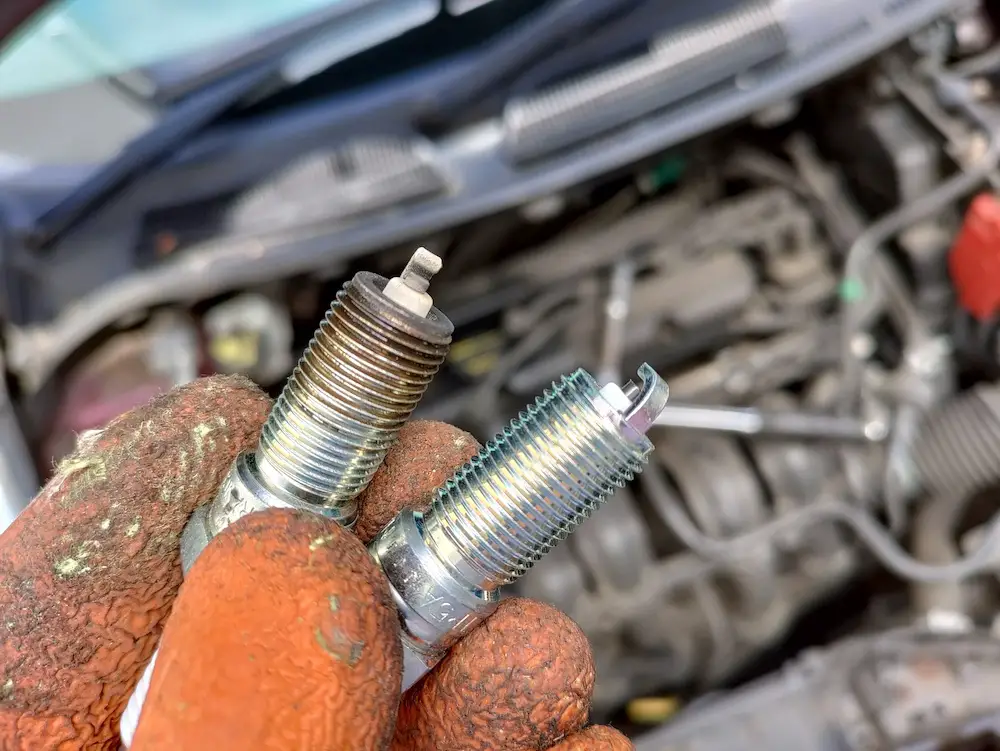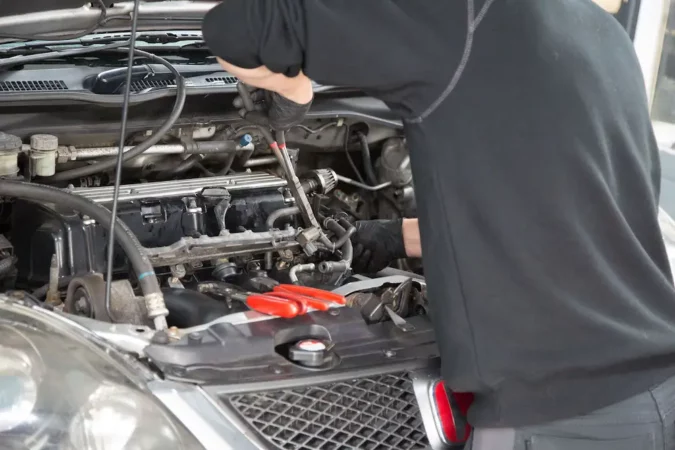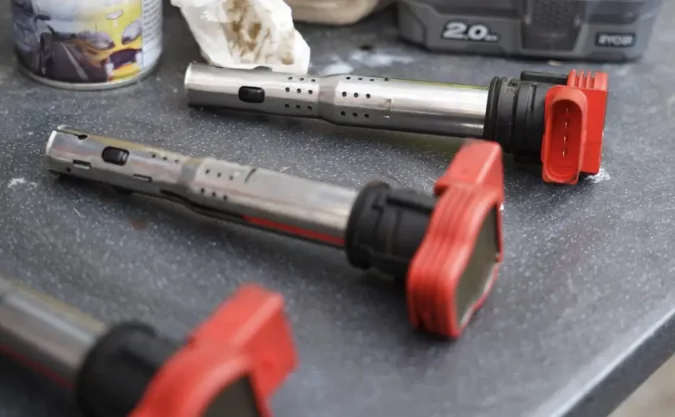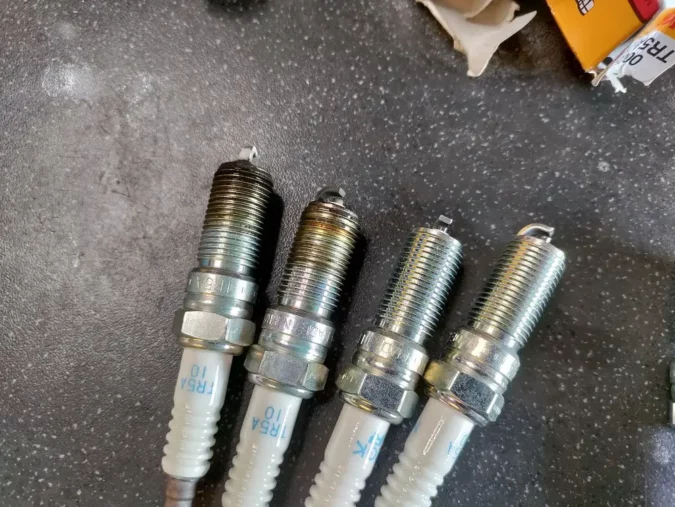P0303 is a diagnostic trouble code (DTC) that indicates a cylinder 3 misfire. The P0303 code meaning, causes, and symptoms are primarily explained in this article. A misfire happens when a cylinder’s fuel burns at an inadequate rate.
The combustion of the air-to-fuel ratio inside the cylinder significantly impacts engine performance. Your cylinder begins misfiring when the air-fuel mixture doesn’t burn properly inside of it. In other words, it’s not getting the most optimal or best air-fuel ratio.
The activation code can be obtained from the car’s onboard diagnostics system and used to quickly identify a misfire. When there is a misfire, the engine speed will fluctuate. Engine Control Modules (ECM) can recognize a misfire if the engine speed changes enough to alter the signal from the crankshaft position (CKP) sensor.
P0303 indicates that cylinder 3 is misfiring at random or sporadically. After an intake leak has been ruled out, examine the cylinder 3 spark plugs for wear and replace them if necessary.
- What Is P0303?
- What Are The Symptoms?
- Types Of Misfires?
- What Are The Causes?
- How To Fix It?
- How To Diagnose It?
- What Is The Cost?
- Mechanical Advice
- How Severe Is It?
P0303
P0303 DTC indicates that cylinder 3 of the engine is misfiring. The Powertrain Control Module (PCM) alerts the engine to set this issue code when it notices that the third cylinder in the engine is misfiring. It is a universal code that applies to all vehicles with OBD-II technology.
Although the P0303 error code may be regarded as generic, the remedies may vary depending on the make and model of your car. If there are several misfires, the P0300 code may also appear in conjunction with other related codes, which indicate issues with more cylinders.
Cylinder 3 Misfire Symptoms
Several things might lead to an engine misfire, such as worn-out spark plugs, a broken ignition system, or an issue with the fuel injection system. Some even wonder whether can bad gas cause a misfire. A cylinder 3 misfire, for example, is a particular kind of misfire that happens when the engine’s third cylinder has a problem.
In this post, we’ll talk about the signs of cylinder 3 misfiring and its causes and potential fixes.
1. Engine Power Loss
A misfire in cylinder 3 can result in an engine power loss, making it more difficult for the car to accelerate or maintain speed. So, if you’re noticing that your car is losing power when accelerating, a misfire might be the cause.
2. Rough Idling
Especially when idling, the engine may start to shake or vibrate excessively. When there is a cylinder 3 misfire, the check engine light will frequently come on. This is what we call a rough idle, and a misfire is among the most common causes of a rough idle.
3. Increased Gasoline Consumption
The engine may require more fuel as it makes up for the misfiring cylinder’s lack of power as a result of a misfire in cylinder 3.
4. Increased Emissions
A misfire can lead to an increase in exhaust emissions due to unburnt fuel leaving the exhausts, which can also turn on the check engine light.
How Can You Determine A Cylinder 3 Misfire
Take note of the freeze frame details of your OBD scanner and recreate the circumstances that triggered the code on a test drive when the Check Engine light illuminates and displays the error code P0303.
The process of diagnosing the issue begins here. RPM, engine load, road speed, and throttle position are all included. It requires a more detailed diagnosis because the error number refers to a particular cylinder misfire.
To fix cylinder misfires, you need to replace malfunctioning parts, such as the ignition coil (aka the coil pack) and spark plugs. This is done to identify the precise reason for the misfire. It’s also important to pay attention to other error codes because other defective parts may be the cause of the misfire.
Here are four typical engine misfire types and instructions for locating the P0303 problem code.
1. Ignition Failure
Check for evidence of heat damage and general wear and tear on the ignition system and all linked parts. A good spark plug should not have soot on it, a white combustion chamber from overheating, or coolant greening. Do refer to our explainer on what does a bad spark plug look like and how to check the spark plugs to learn more.
Instead, it ought to keep its sandy hue. Arcing shouldn’t occur in the ignition system’s cables or coils. If necessary, inspect the ignition system to ensure that it is firing at consistent voltages, which should be between 8 and 10 volts for each cylinder.
The engine should have the distributor cap and rotor removed, if necessary. Look for evidence of corrosion buildup, wear and tear, or arching at the contact points and terminals. Even though computer-controlled trimming is typically included in OBD II systems, check sure it meets the correct criteria, even if it uses individual coils.
2. Lean Fuel Mixture
Take note of the Long Fuel Trim values while looking for lean misfires because they affect how the PCM (Powertrain Control Module) adjusts the air/fuel ratio balance. A vacuum leak, crack, or other faults on the designated bank’s manifold may cause a result that indicates more than 10% in one cylinder bank but not in the other.
By examining the “numbers” of the Fuel Trim under the complete range of operating circumstances, you may determine what triggers the computer to perform the compensation. Engines in good condition have Long Term Fuel Trim figures that are 1% to 3% positive or negative.
3. Mechanical Failure
Both a compression test and an idle manifold vacuum test can be used to look for this misfire. Consistent compression readings (approximately 10% of each other), a minimum of 120 PSI for each cylinder, and at least 17 inches of stable vacuum are required for complete and smooth combustion.
Causes Of A Cylinder 3 Misfire
The ECU sets the P0303 DTC as a result of several cylinder 3 misfires. When there are misfires, the ECU turns on the Check Engine Light and switches the car into the failsafe mode to stop further damage. If the code is not fixed, the Check Engine Light will continue to be on.
Several things, such as defective ignition systems, fuel systems, and internal engine issues, might lead to misfires in cylinder 3.
This frequently occurs when spark plug coil packs are defective or worn out, especially if a tune-up hasn’t been done recently. However, a misfire that results in a stored P0303 issue code can have various probable causes. The P0303 error code could have several reasons, including the following:
Mechanics-related issues with the engine, like:
- The head gasket is leaking
- A broken lifter or worn camshaft lobes
- Damage to the cylinder walls, pistons, or wear and tear on the piston rings
- The valve has a leak
Fuel supply problems, including:
- For instance, damaged injector drivers may result in issues with the powertrain control module
- Wires and connectors in the fuel injector circuit may be loose
- An issue with the fuel injector exists
Ignition system issues, including:
- Vehicle spark plug wires that aren’t functional
- Failures of coil packs or coils-on-plugs
- The spark plug is defective and worn out
Cylinder 3 Misfire Fix
The spark plugs or wiring are probably the cause of the problem if you also notice hesitation or stumbling from the engine in addition to the error number. Verify the integrity and safety of the connectors and wiring connected to the problematic cylinder.
Depending on how old the car is, replacing these ignition parts as part of routine maintenance might be beneficial. The catalytic converter might also have broken down. You can be certain that this is the case if the exhaust has a stench similar to rotten eggs.
You should assess your abilities before attempting any of these replacements because you do not want to endanger your car with further harm. But occasionally, a computer simply fails and needs to be reset.
It can be annoying to receive the P0303 OBD-II scanner error code. Finding the cause of the issue and fixing your car will involve some time and the necessary knowledge, but you can do it.
P0303 Cylinder 3 Misfire Detected
It will be more challenging to determine the reason for a P0303 engine code when other codes are pulled than if a diagnostic test reveals a single-cylinder misfire. Next, the typical procedures for diagnosing a P0303 code are listed below:
Step 1:
Use a diagnostic testing device to look for other codes. If there are any additional DTCs, take care of them before continuing.
On a side note, it’s also worth being diligent for other misfire-related OBD error codes. These will show that you have misfires in other cylinders or a random misfire. Some of the more common engine misfire-related diagnostics trouble codes include:
- P0300 Code (including make/model-specific ones, such as P0300 Chevy or P0300 Nissan)
- P0301 Code (a cylinder 1 misfire)
- P0302 Code (a cylinder 2 misfire)
- P0303 Code
- P0304 Code (a cylinder 4 misfire)
- P0305 Code
- P0306 Code
Step 2:
Verify that the wiring for cylinder #3 is not damaged or has any loose connections, and look for any loose engine ground wires. Any loose connections or damaged wiring that might be the reason for engine misfires should be tightened, fixed, or reconnected.
Step 3:
Check to see if the spark plug wires and plugs are in good shape. A faulty spark plug can be identified by switching the plug from cylinder #3 to cylinder #2 and then running the diagnostic test to determine if a P0302 error message appears.
Therefore, swap out the spark plugs and then recheck for any misfires that may still be present. Engines that utilize individual coil packs rather than spark plug wires can still employ the same procedures for changing and inspecting their component parts.
Otherwise, be mindful of the symptoms of a bad spark plug, or perhaps the symptoms of a bad ignition coil. Let’s wrap up our P0303 DTC diagnostic procedures with our final two suggestions for locating and resolving the misfiring issue.
Step 4:
Detecting fuel system issues is the fourth diagnostic step. After establishing that your ignition system is functioning properly and after completing the previous diagnostic procedures, the P0303 code may be caused by underlying fuel system problems. To identify a P0303 engine code, the next two confirmations need to be made:
- Determine if there are any fuel pressure problems right now. Engine misfires may be caused directly by improper and low fuel pressure. Engine misfires result from engines receiving the wrong amount of gasoline under inappropriate fuel pressure. The gasoline pump or fuel pressure regulator may be at fault for this specific issue. As such, check for any symptoms of a bad fuel pressure regulator, or a faulty fuel pressure sensor.
- Verify that the fuel injectors are operating properly. Engine misfires may also be a direct result of fuel injectors that need to be replaced if they are damaged. Additionally, ensure that the fuel injector wiring is secure, connected, and unharmed. Elsewhere, make sure that you’re not noticing any dirty fuel injectors or the symptoms of a bad fuel injector.
Step 5:
Engine compression and leak-down tests are the fifth steps in the diagnostic process. It’s time to do an engine compression and leak-down test after ensuring that all fuel system and ignition components are operating correctly.
These tests can reveal any additional engine issues that could lead to misfires. These various issues include those listed below that can cause a P0303 misfire:
- Burnt valve or worn valve guides
- A faulty valve spring
- Defective or damaged timing chain
- Broken piston ring
A variety of mechanical issues can bring on engine misfires. Therefore, it may be crucial to check engine compression (and note the symptoms of low compression) and run a leak-down test to find any broken mechanical parts.
These tests, which are typically the last ones performed when diagnosing a P0303 misfire, may hold the key to identifying the root of your engine misfiring issue. Diagnosing a P0303 engine code or other cylinder misfires sometimes overlooks other parts, such as broken or disconnected vacuum lines.
To eliminate them as potential misfire catalysts, it is crucial to ensure all other electrical connectors are connected or fitted correctly.
Cylinder 3 Misfire Cost
Depending on the reason for the misfire and the make and model of your car, the cost to repair a cylinder 3 misfire can differ significantly. A cylinder 3 misfire may require a number of standard repairs. Therefore, the cost to fix an engine misfire varies depending on:
- Spark plug replacement cost: $20 to $100 or more (and take into account how many spark plugs in a V8)
- Fuel injector replacement cost is in the range of $50 to $200.
- A new ignition coil will cost between $70 and $300 (be wary of the differences between the ignition coil vs spark plug).
- Replacement of suction hoses or an intake gasket costs between $50 and $200.
- Depending on the make and model of the car, replacing an engine control module might cost anywhere from $300 to $1000 or more.
It’s crucial to remember that these are just approximate figures, and the actual cost of repairs will vary depending on the precise vehicle and location of the repair. Prior to providing a more precise cost estimate, a correct diagnosis of the misfire and its particular cause is required.
P0303 Code: Mechanics’ Advice
Replace the spark plug in cylinder 3 and continue if you discover that it is the source of the p0303 error. Replacing all of the plugs at once is always the wiser course of action. If one fails, the others will surely follow shortly after. Additionally, you may easily adhere to a suggested maintenance schedule by replacing all spark plugs.
Additionally, you want to confirm that the spark plugs are properly gapped. A misfire might readily result from a gap that is either too tiny or too large. To ensure the gap complies with the manufacturer’s specifications, use a spark plug gap tool (and learn how to gap spark plugs and the other tools needed for a spark plug change).
How Serious Is Code P0303
DTC P0303 is typically thought to be fairly severe in nature. This misconception frequently stems from two factors. In addition to the numerous driveability-related problems that frequently accompany DTC P033, an unattended misfire might eventually result in a variety of additional problems.
Unburned fuel travels downstream, through a car’s exhaust, when it is not burned as intended, as can happen in the case of a cylinder misfire. This gasoline is then overheated, which increases the likelihood that several parts, including the catalytic converter, would sustain damage.
To reduce further risk, a P0303 misfire code should be fixed as soon as possible. Take your car to a reputable repair shop as soon as you can if you lack the confidence to identify the problem yourself.
Common Errors In P0303 Diagnosis
The coil pack, wires, ignition coils, or spark plugs will typically be at fault for the misfire. However, without first carrying out the diagnostic procedures we describe, you should never presume that’s the issue. Before replacing it, you should visually inspect the plugs, wires, coils, and coil pack.
If these components appear to be in good condition, you should move on to other components that might be malfunctioning, such as the fuel injectors or valves. Additionally, you ought to do a compression test. If there are more fault codes, these may also help you determine the issue.
FAQs On Cylinder 3 Misfire
How To Fix Misfire Cylinder
A malfunctioning spark plug, a clogged fuel injector, an issue with the ignition coil, or a vacuum leak are a few examples of the potential causes of a misfiring cylinder. Some basic troubleshooting procedures may be required to fix a misfire cylinder, such as checking the fuel pressure and replacing the fuel filter if necessary, inspecting the spark plugs and replacing them if they are worn or damaged, and checking the ignition coils and replacing them if they are damaged. You might also need to look for vacuum leaks in the intake manifold or hoses and fix or swap out any broken components.
What Does Misfiring Mean
When an internal combustion engine cylinder fails to ignite properly, it is referred to as misfiring. There are several reasons why this may occur, but often the cylinder isn’t getting enough gasoline or spark. A misfired cylinder results from the spark plug failing to ignite the fuel-air mixture inside the cylinder, which reduces power and increases emissions. The engine may tremble and create a popping or knocking noise due to misfiring.
What Causes Cylinder Misfire
An internal combustion engine experiences a cylinder misfire when a cylinder doesn’t ignite properly. A number of problems can bring this on, including worn or fouled spark plugs that prevent the proper ignition of the fuel-air mixture in the cylinder, clogged fuel injectors or fuel pressure issues that prevent the proper amount of fuel from reaching the cylinder, malfunctioning ignition coils or issues with the distributor cap and rotor that prevent the spark plug from firing, and vacuum leaks that can affect the air-fuel mixture and result in cylinder misfiring.
Can A Bad Catalytic Converter Cause A P0300 Code
An issue with the catalytic converter may result in the P0300 code, which denotes a random or multiple-cylinder misfire. However, a P0300 code is not typically caused by a catalytic converter. Faults with ignition or fuel systems, such as faulty spark plugs, fuel injectors, or a vacuum leak, more frequently bring on a P0300 code.
Which Cylinder Is Number 3
Depending on the kind and layout of the engine, the number of cylinders can change. The layout and configuration of the engine indicate where cylinder number 3 will typically be located, which is in the middle of the engine.
How Much Does It Cost To Fix A Misfire
Depending on the misfire’s source and the vehicle’s make and model, the cost to repair a misfire can range greatly, from as little as $20 for changing a spark plug to as much as $1000 or more for replacing the engine control module.
Will A Bad Coil Pack Throw A Code
Depending on the type of vehicle and its onboard diagnostic system, a faulty coil pack may potentially set off a P0300 code (random/multiple cylinder misfire) or a P0301-P0306 code (misfire in the specific cylinder).
Can Fuel Injector Wire Cause Misfire
A wire may bring on a misfire for a fuel injector that is broken or not working properly. A misfire may occur as a result of inadequate gasoline getting to the cylinder.
Is A Misfiring Cylinder Expensive To Fix
Depending on the reason for the misfire, the make and model of the vehicle, the cost to repair a misfiring cylinder can range from a few hundred dollars to thousands of dollars.
Can You Drive With A Cylinder 3 Misfire
Driving a car with a cylinder 3 misfire is not advised since it might reduce power, increase emissions, and harm the catalytic converter. The vehicle has to be inspected and fixed as soon as feasible. If the issue that caused the misfire is not fixed, it may further harm the engine. Driving a car while the check engine light is on and it is releasing too much pollution is also prohibited.
Can A Bad Coil Pack Cause Knocking
Engine knocking, also known as detonation or pinging, can be brought on by a defective coil pack. This is due to the possibility that a defective coil pack will not be able to generate a spark that is powerful enough to ignite the gasoline and air combination in the engine’s cylinders. As a result, the mixture might not burn uniformly, which could cause the engine to knock or tap.
Can A Misfire Fix Itself
Depending on the reason for the misfire, a misfire can occasionally be fixed. However, the misfire will frequently continue until the underlying problem is resolved. The engine control module stores the code P0303, which refers to a misfire in cylinder number 3, when it notices that the engine is not operating smoothly in this particular cylinder. This causes the check engine light to illuminate on the dashboard. It must be fixed as quickly as possible because it could harm the catalytic converter and other emissions systems.
Cylinder 3 Misfire: Final Verdict
It is crucial to have a scanner that can monitor real-time engine data from sensors for troubleshooting cylinder 3 misfire. Technicians can view real-time fuel trims on the screen in addition to long-term fuel trims, intake air sensor data, fuel injector operation, and misfire counters.
This information is used to identify which system is causing the issue and calculate P0303. Every step must be followed to avoid mistakes that waste time and money during a diagnostic.
Mistakes like leaking air intakes or problems with the fuel supply can sometimes result in flames. For instance, P0303 is frequently caused by spark plugs, but they are not the only reason.






2 comments
Thank you for all the info I have changed all spark plugs and the number 4 coil run injecter cleaner thru the system and now it’s just the number 3 misfire what do I do next
I’m sorry to hear that you’re still experiencing a misfire on cylinder 3, Jerry. It’s great that you’ve already taken some proactive steps by changing all the spark plugs and the number 4 coil, as well as running injector cleaner through the system. Since the misfire is now isolated to cylinder 3, there are a few more things you can try to resolve the issue.
Firstly, you may want to consider swapping the ignition coil from cylinder 3 with a coil from another cylinder to see if the misfire moves along with it. If the misfire shifts to the cylinder where you moved the coil, then it’s likely that the coil itself is faulty and needs to be replaced.
Another potential cause for a cylinder 3 misfire could be a problem with the fuel injector. You can try swapping the injector from cylinder 3 with one from another cylinder to see if the misfire follows. If it does, then the fuel injector may need to be cleaned or replaced.
Additionally, it’s worth checking the compression on cylinder 3 to ensure it’s within the manufacturer’s specifications. Low compression can also lead to a misfire. A compression test can help identify if there are any issues with the valves or piston rings in that cylinder.
If you’ve exhausted these troubleshooting steps and the misfire still persists on cylinder 3, it might be beneficial to consult a professional mechanic who can perform more advanced diagnostics. They will have the necessary tools and expertise to pinpoint the exact cause of the misfire and provide you with the most appropriate solution.
Keep in mind that addressing a misfire can sometimes require a bit of trial and error, but with persistence and the right guidance, you’ll likely be able to resolve the issue. I wish you the best of luck in getting your vehicle back to its optimal performance.